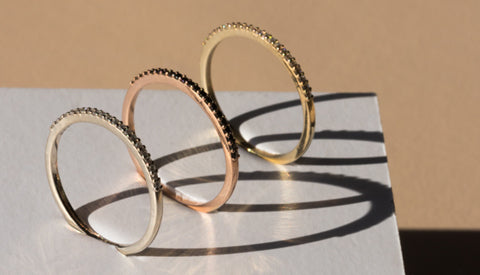The 4C's of a Diamond
DIAMOND COLOUR | Diamond Color Actually Means Lack of Color
The diamond color evaluation of most gem-quality diamonds is based on the absence of color. A chemically pure and structurally perfect diamond has no hue, like a drop of pure water, and consequently, a higher value.
Many of these color distinctions are so subtle that they are invisible to the untrained eye; however, these distinctions make a very big difference in diamond quality and price.

DIAMOND CLARITY | Diamond Clarity Refers to the Absence of Inclusions and Blemishes
Natural diamonds are the result of carbon exposed to tremendous heat and pressure deep in the earth. This process can result in a variety of internal characteristics called ‘inclusions’ and external characteristics called ‘blemishes.’
While no diamond is perfectly pure, the closer it comes, the higher its value.
There are 6 categories, some of which are divided, for a total of 11 specific grades.
- Flawless (FL) No inclusions and no blemishes visible under 10x magnification
- Internally Flawless (IF) No inclusions visible under 10x magnification
- Very, Very Slightly Included (VVS1 and VVS2) Inclusions so slight they are difficult for a skilled grader to see under 10x magnification
- Very Slightly Included (VS1 and VS2) Inclusions are observed with effort under 10x magnification, but can be characterized as minor
- Slightly Included (SI1 and SI2) Inclusions are noticeable under 10x magnification
- Included (I1, I2, and I3) Inclusions are obvious under 10x magnification which may affect transparency and brilliance
Many inclusions and blemishes are too tiny to be seen by anyone other than a trained diamond grader. To the naked eye, a VS1 and an SI2 diamond may look exactly the same, but these diamonds are quite different in terms of overall quality.

What Causes Inclusions?
Small crystals can become trapped in a diamond when it’s forming. Sometimes as a crystal grows it can develop irregularities in its atomic structure.
DIAMOND CUT | A Diamond’s Cut Unleashes Its Light
- Brightness: Internal and external white light reflected from a diamond
- Fire: The scattering of white light into all the colors of the rainbow
- Scintillation: The amount of sparkle a diamond produces, and the pattern of light and dark areas caused by reflections within the diamond
DIAMOND CARAT WEIGHT | Diamond Carat Weight Measures a Diamond’s Apparent Size
A carat refers to the size of your diamond and is a measure of weight. A carat is divided into 100 points.
Carat weight alone does not determine the value of a diamond. For instance, it is very possible for a smaller diamond to be worth much more than a larger one. The other three C’s must be considered when assigning value to a diamond.
How did the carat system start?
The modern carat system started with the carob seed. Early gem traders used the small, uniform seeds as counterweights in their balance scales. The carat is the same gram weight in every corner of the world.

